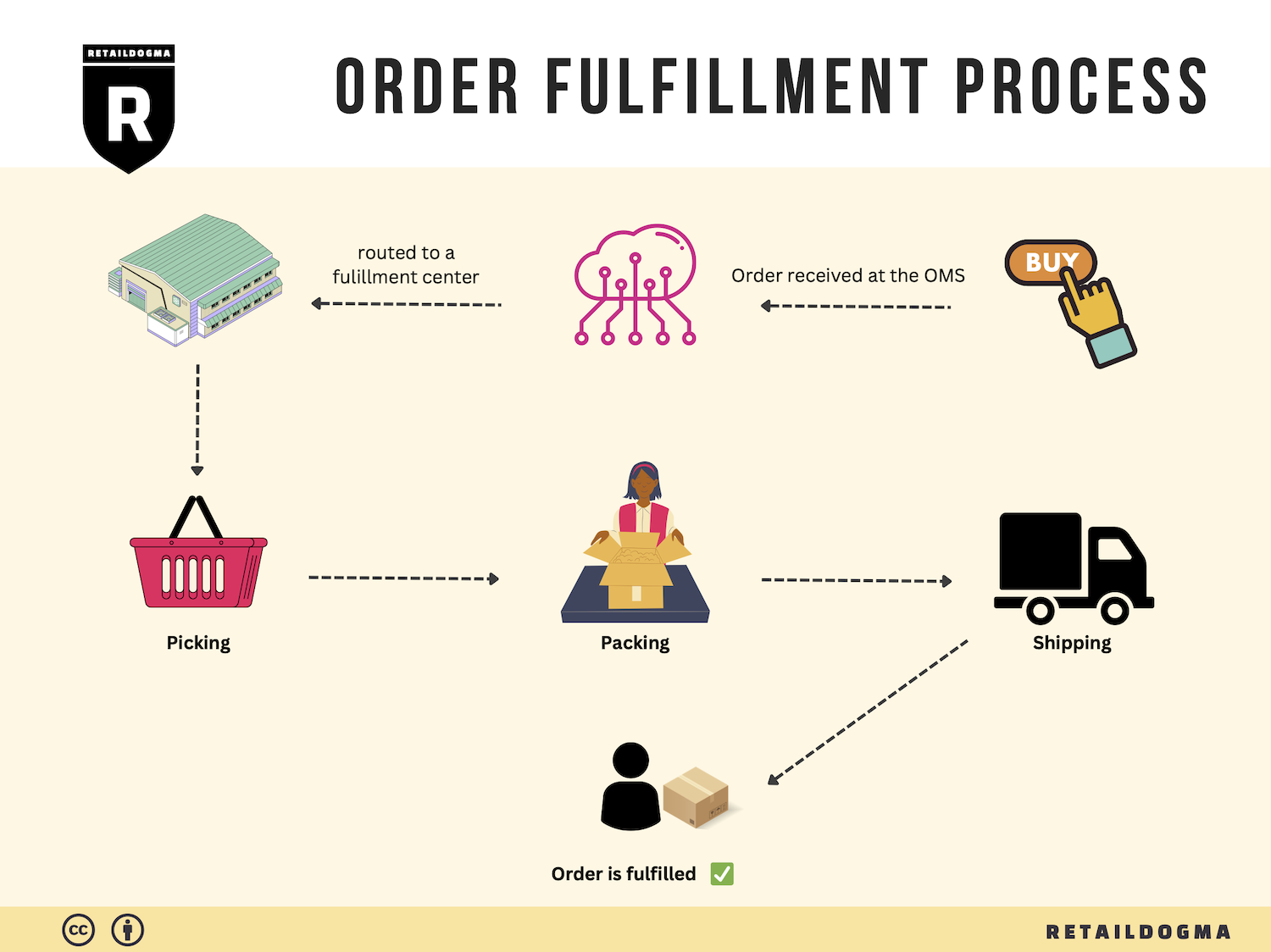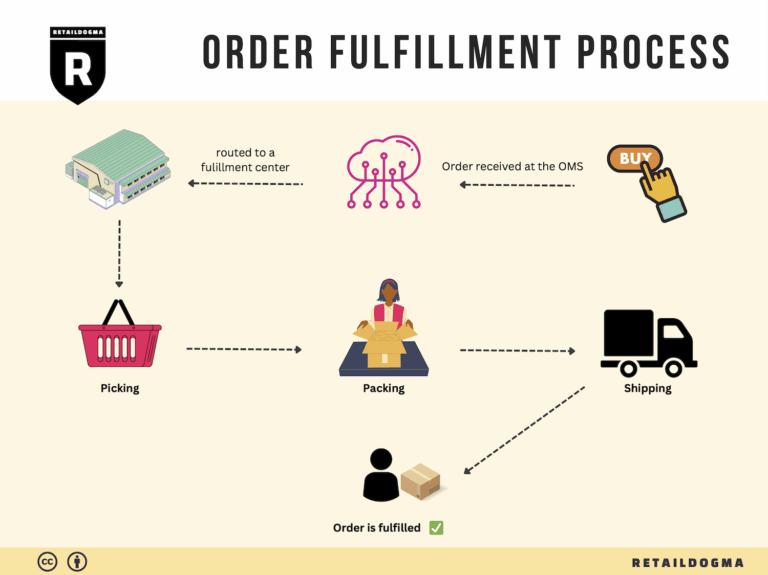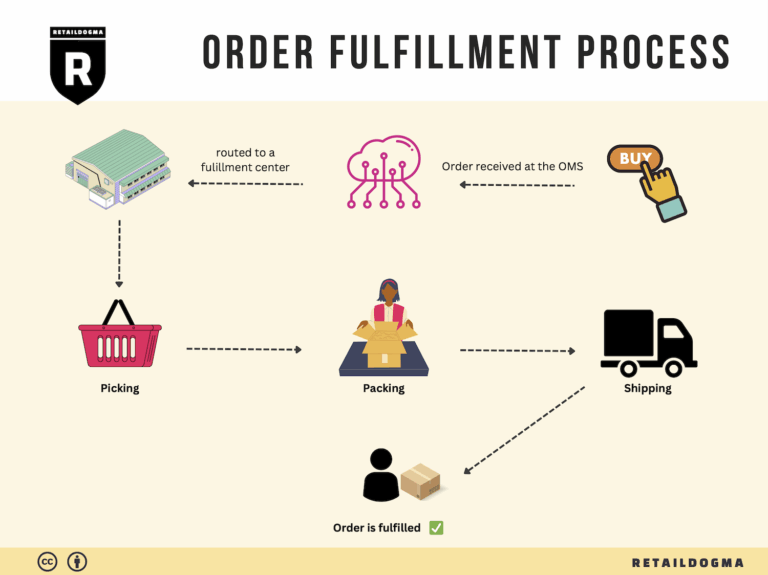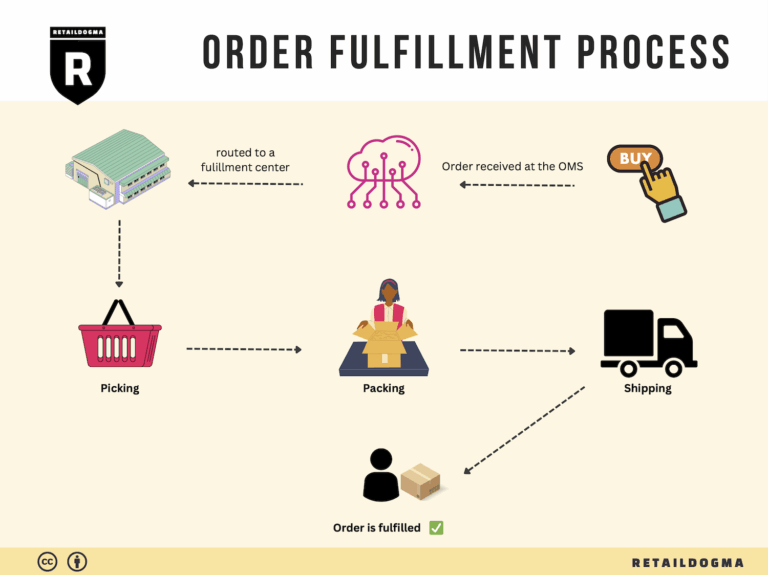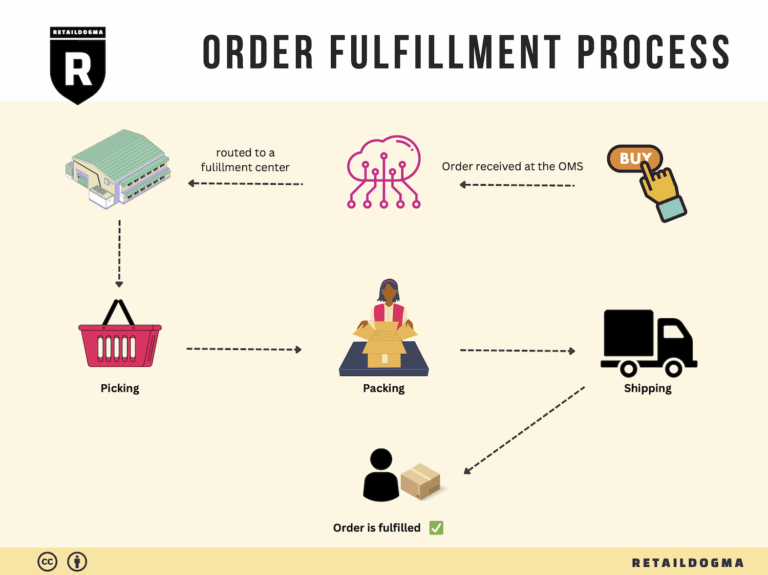Ecommerce Fulfillment Services: The Ultimate Guide (2025)
What is E-commerce Fulfillment? An Introduction for Growing Businesses
Understanding E-commerce Fulfillment
As e-commerce businesses grow, many owners quickly find themselves overwhelmed by the complexities of packing and shipping orders. The excitement of increasing sales can quickly turn into a logistical nightmare, leading to delays, errors, and unhappy customers. This is where the concept of fulfillment becomes crucial. Simply put, fulfillment is the process of getting a product from your inventory to your customer’s doorstep. It encompasses everything from receiving orders to processing payments, picking and packing items, and finally shipping them out.
In this guide, we will delve into the various models of e-commerce fulfillment, such as Third-Party Logistics (3PL) and Fulfillment by Amazon (FBA). Each model has its own set of advantages and challenges, making it essential for business owners to understand which option aligns best with their operational needs and customer expectations.
Core Services of Fulfillment
We will outline the core services involved in the fulfillment process, including inventory management, order processing, packing, shipping, and returns management. Understanding these services will help you identify what you need from a fulfillment partner and how they can enhance your overall customer experience.
Choosing the Right Partner
Selecting a fulfillment partner is a critical decision that can impact your business’s efficiency and customer satisfaction. This guide will provide you with practical criteria to evaluate potential partners, including their technology, scalability, service levels, and geographical reach. We’ll also touch on the importance of aligning your partner’s capabilities with your business goals.
Pricing Considerations
Pricing can often be a significant concern when it comes to fulfillment services. We will explore the factors that influence pricing structures, such as storage fees, shipping costs, and service charges. Gaining a clear understanding of these costs will empower you to make informed financial decisions and negotiate better terms with your chosen partner.
Empowering Your Business Decisions
Ultimately, the goal of this guide is to empower e-commerce business owners and operations managers to make smart, strategic decisions regarding their logistics. By understanding the intricacies of fulfillment and the options available, you can streamline your operations, improve your customer service, and scale your business effectively. Whether you’re just starting out or looking to optimize your existing processes, this comprehensive guide will serve as a valuable resource in your e-commerce journey.
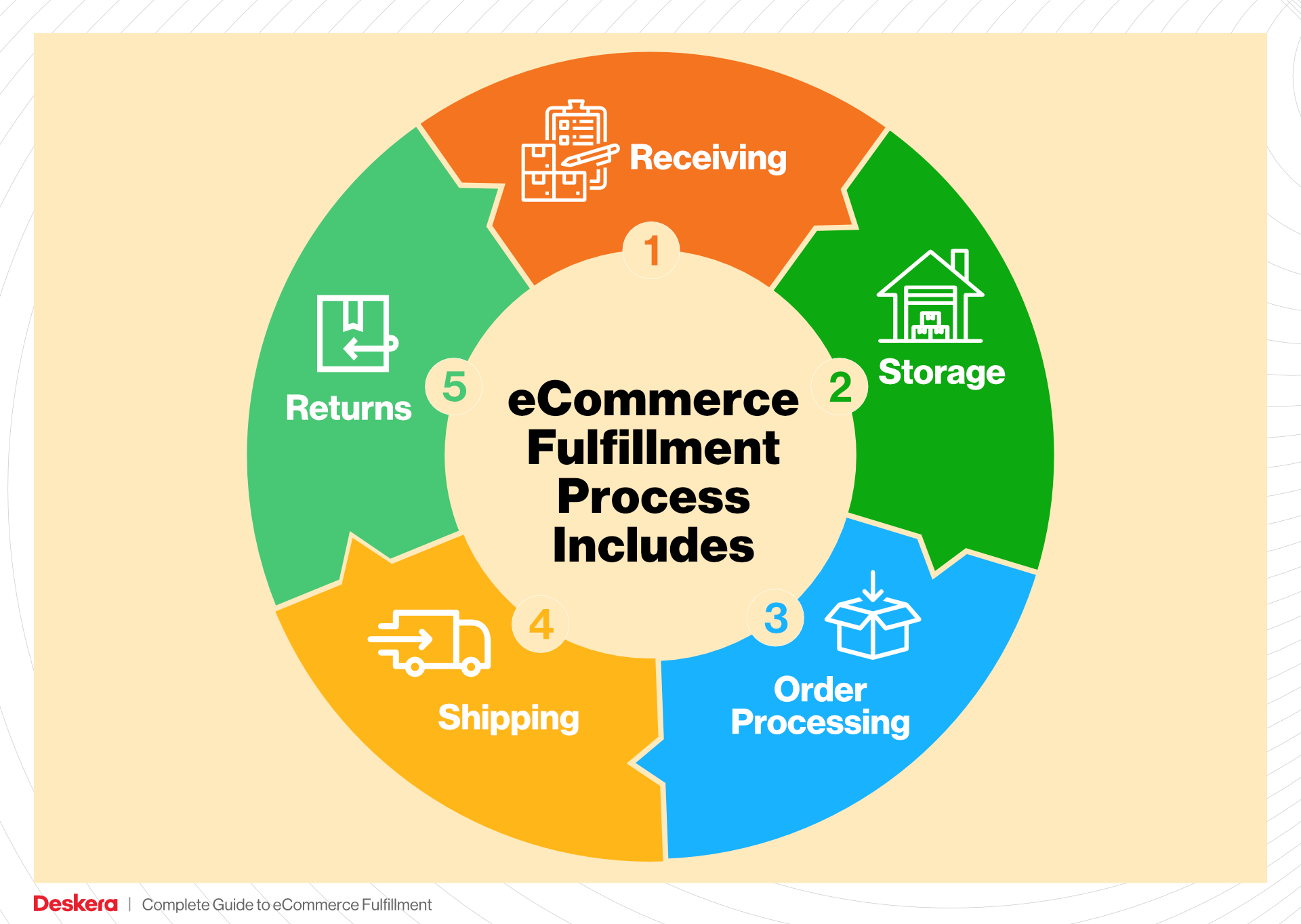
What You’ll Learn In This Guide
- What is E-commerce Fulfillment? An Introduction for Growing Businesses
- The Order Fulfillment Process: From ‘Buy’ Button to Customer’s Door
- Comparing Fulfillment Models: In-House vs. 3PL vs. Dropshipping
- A Deep Dive into Amazon FBA: Pros, Cons, and Who It’s For
- Core Services Offered by Fulfillment Centers
- How to Choose a Fulfillment Partner: A 6-Point Checklist
- Understanding Fulfillment Pricing: A Breakdown of Common Fees
- Frequently Asked Questions (FAQs) about Fulfillment
- Conclusion: Is Outsourcing Fulfillment the Right Move for Your Business?
- Important Disclaimer
The Order Fulfillment Process: From ‘Buy’ Button to Customer’s Door
1. Receiving Inventory
The first step in the order fulfillment process is receiving inventory. When products arrive at the Amazon Fulfillment Center – MDW9, they undergo a thorough inspection to ensure that the correct items and quantities have been delivered. This process involves checking against purchase orders, which helps to maintain inventory accuracy. A key term associated with this step is SKU (Stock Keeping Unit), which is a unique identifier assigned to each product that simplifies tracking and management.
Receiving inventory is crucial for several reasons. It sets the foundation for efficient inventory management and ensures that the warehouse has the right products on hand to meet customer demand. A well-organized receiving process minimizes errors and discrepancies, which can lead to delays further down the fulfillment chain. By accurately logging inventory as it arrives, businesses can maintain optimal stock levels and reduce the risk of stockouts.
2. Warehouse Storage
Once inventory is received, the next step is warehouse storage. Products are systematically stored in designated areas within the fulfillment center based on their SKUs, size, and demand frequency. This process often utilizes advanced warehouse management systems (WMS) that optimize space utilization and facilitate quick access to items. Key terms here include bin location and inventory turnover, which refer to the specific spots where products are stored and the rate at which inventory is sold and replaced, respectively.
Effective warehouse storage is vital because it directly impacts the efficiency of order picking and packing. Proper organization allows for faster retrieval times, which is especially important during peak seasons when order volumes surge. Additionally, smart storage strategies—like placing high-demand items closer to packing areas—can significantly enhance operational efficiency and reduce labor costs.
3. Order Picking
Order picking is the process of retrieving items from their storage locations to fulfill customer orders. This step typically involves the creation of pick lists, which are documents or digital manifests that outline the items needed for each order, along with their respective locations in the warehouse. Efficient picking methods, such as batch picking or zone picking, can be employed to optimize this process.
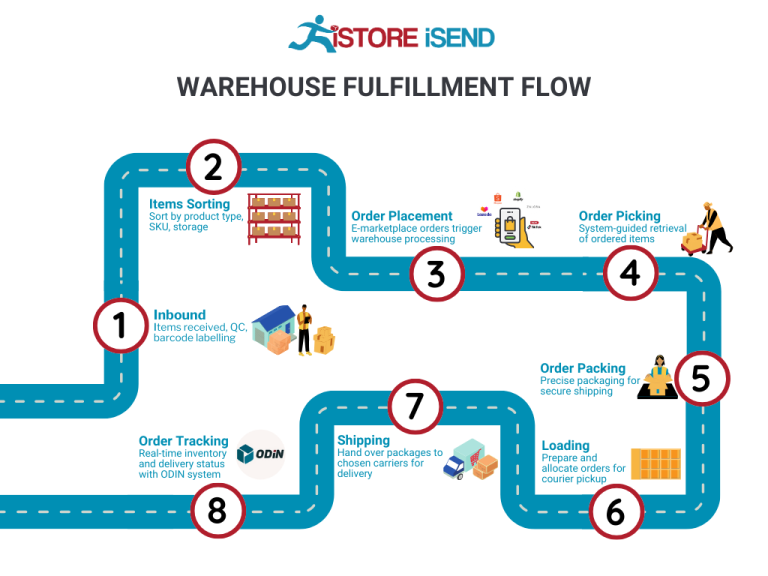
The importance of order picking cannot be overstated; it is a critical determinant of order accuracy and speed. Errors during picking can lead to customer dissatisfaction, increased returns, and additional operational costs. Therefore, utilizing technology such as barcode scanners or RFID (Radio Frequency Identification) systems can enhance accuracy and speed by ensuring that the correct items are selected for each order. A well-executed picking process not only improves customer satisfaction but also contributes to overall operational efficiency.
4. Order Packing
After items have been picked, they proceed to the packing stage. During packing, products are carefully placed in appropriate packaging materials to ensure they are protected during transit. This process often involves using packing slips, which include important information about the order, such as item descriptions and shipping details. A key term associated with packing is dimensional weight, which refers to the shipping cost calculation based on package dimensions rather than just weight.
Packing is a critical step because it influences shipping costs and delivery reliability. Properly packed orders reduce the likelihood of damage during transit, thereby minimizing returns and enhancing customer satisfaction. Additionally, efficient packing processes can lead to better space utilization in shipping containers, potentially lowering shipping expenses. The goal is to strike a balance between adequate protection for the items and cost-effective use of materials.
5. Shipping & Delivery
The final step in the order fulfillment process is shipping and delivery. Once packages are packed, they are labeled and dispatched to the appropriate carriers for delivery. This stage involves logistics planning and coordination to ensure timely and accurate deliveries. Key terms to note include last-mile delivery, which refers to the final leg of the delivery journey to the customer’s doorstep, and tracking number, which allows customers to monitor their order’s progress.
Shipping and delivery are pivotal for customer satisfaction and can significantly impact a business’s reputation. Timely deliveries enhance the customer experience and build trust, leading to repeat business. Utilizing advanced shipping solutions and partnerships with reliable carriers can streamline this process, ensuring that orders are delivered on time and in good condition. Additionally, providing customers with tracking information empowers them and reduces inquiries about order status, further enhancing the overall fulfillment experience.
In conclusion, understanding and optimizing each step of the order fulfillment process—from receiving inventory to shipping and delivery—can significantly enhance operational efficiency, improve customer satisfaction, and ultimately contribute to the scalability of an e-commerce business. Each phase plays a crucial role in ensuring that customers receive their orders promptly and accurately, which is essential for long-term success in the competitive e-commerce landscape.
Comparing Fulfillment Models: In-House vs. 3PL vs. Dropshipping
Comparison of Fulfillment Models
| Model | Who Handles Inventory | Best For (Business Stage) | Key Advantage | Key Disadvantage |
|---|---|---|---|---|
| In-House Fulfillment | Business itself | Established businesses | Greater control over inventory | Higher operational costs |
| Third-Party Logistics (3PL) | Third-party logistics provider | Growing businesses | Scalability and reduced overhead | Less control over the fulfillment process |
| Dropshipping | Supplier | Startups or small businesses | Low upfront investment | Lower profit margins and longer shipping times |
In-House Fulfillment
In-house fulfillment involves managing the entire logistics process within the business. This model is typically adopted by established companies that have sufficient resources and infrastructure to handle inventory management, order processing, and shipping. The key advantage of in-house fulfillment is the level of control it offers. Businesses can oversee their inventory, streamline their operations, and ensure quality control at every stage of the fulfillment process. This model also allows for faster response times to customer inquiries and the ability to customize packaging and shipping methods to enhance customer experience.
However, in-house fulfillment comes with significant disadvantages, primarily related to cost and complexity. Businesses must invest in warehousing, technology, and labor, which can lead to higher operational expenses. Additionally, as order volumes fluctuate, maintaining optimal staffing levels and warehouse space can become challenging, leading to inefficiencies. This model may not be sustainable for businesses looking to scale quickly, as the associated costs and resource demands can hinder growth.
Third-Party Logistics (3PL)
Third-party logistics (3PL) providers offer a comprehensive solution for businesses looking to outsource their fulfillment operations. This model is particularly beneficial for growing businesses that need to scale their logistics without the burden of managing every aspect of the fulfillment process. 3PL providers handle inventory storage, order processing, shipping, and often even customer service. This allows businesses to focus on their core competencies, such as marketing and product development.
One of the key advantages of using a 3PL is scalability. As order volumes increase, businesses can easily adjust their logistics needs without the need for significant capital investment in infrastructure. Additionally, 3PL providers often have established relationships with carriers, which can lead to cost savings on shipping. However, the downside is that businesses may have less control over the fulfillment process. This can lead to inconsistencies in service quality and potential communication issues between the business and the 3PL provider, which can ultimately affect customer satisfaction.
Dropshipping
Dropshipping is a fulfillment model where the retailer does not hold inventory but instead transfers customer orders directly to a supplier, who then ships the products directly to the customer. This model is particularly attractive to startups or small businesses with limited resources and is often seen as a low-risk way to enter the e-commerce market. The primary advantage of dropshipping is the low upfront investment required, as businesses do not need to purchase inventory or manage warehousing.
However, dropshipping also presents several challenges. One major disadvantage is the lower profit margins, as suppliers typically charge retailers a premium for their services. Additionally, businesses may face longer shipping times and less control over the quality of the products being shipped, which can lead to customer dissatisfaction. Moreover, relying on suppliers for inventory means that businesses must be diligent about managing relationships and ensuring that stock levels are sufficient to meet customer demand.
Conclusion
In summary, each fulfillment model presents unique advantages and disadvantages that can significantly impact a business’s logistics strategy. In-house fulfillment offers control but at a higher cost, making it suitable for established businesses. Third-party logistics provide scalability and efficiency for growing companies but may lead to reduced control over the fulfillment process. Finally, dropshipping is an excellent entry point for startups due to its low investment requirement, but it can compromise profit margins and customer experience. As businesses evaluate their growth strategies, understanding these models will help them make informed decisions about their fulfillment approach.
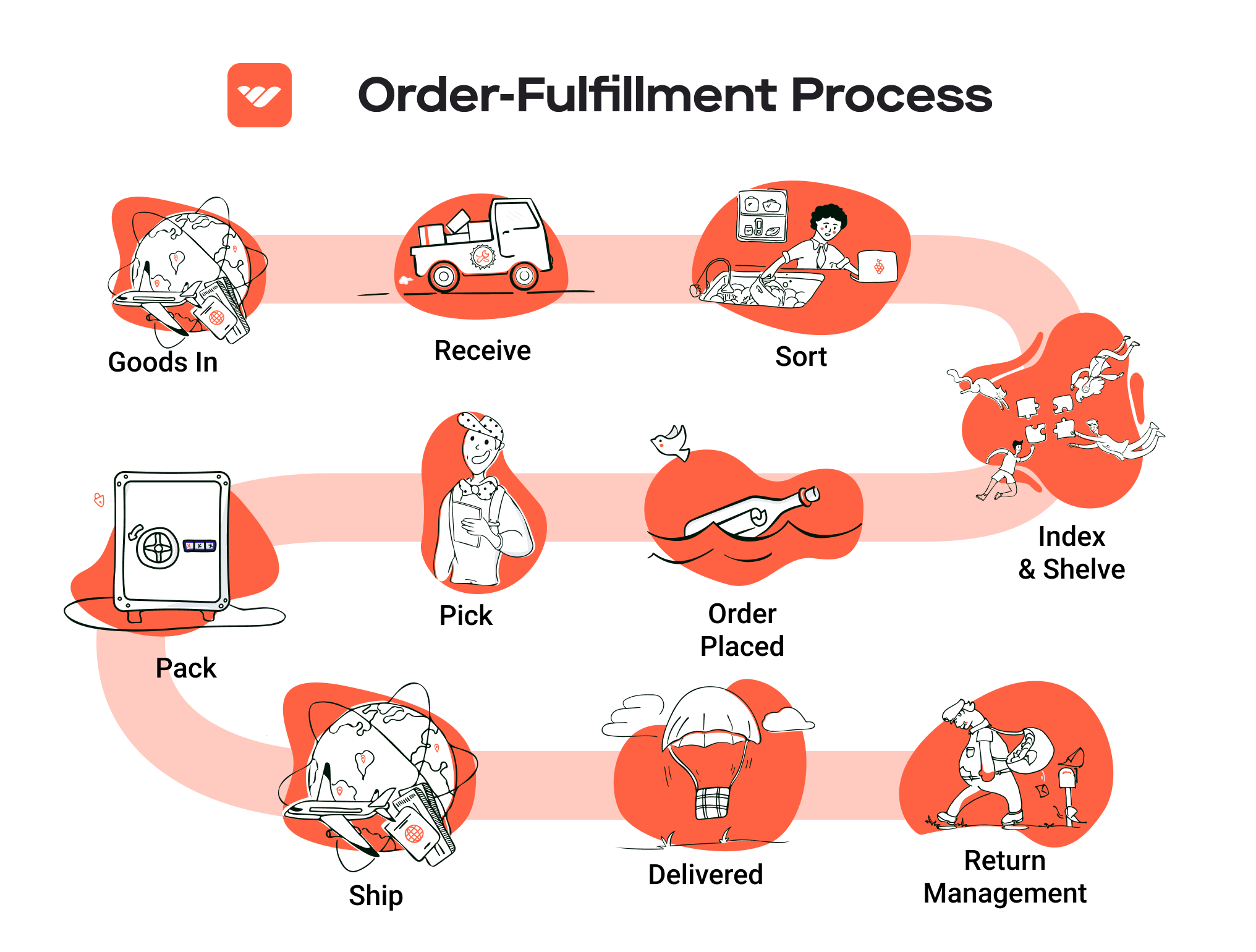
A Deep Dive into Amazon FBA: Pros, Cons, and Who It’s For
Understanding Fulfillment by Amazon (FBA)
Fulfillment by Amazon (FBA) is a service provided by Amazon that allows sellers to store their products in Amazon’s fulfillment centers. Amazon takes care of storage, packaging, and shipping of products directly to customers. This service enables e-commerce businesses to leverage Amazon’s vast distribution network and customer service capabilities, allowing sellers to focus on other aspects of their operations, such as marketing and product development.
How FBA Works
-
Product Storage: Sellers send their inventory to Amazon’s fulfillment centers, like MDW9 in Naperville, IL. Amazon stores these products until they are sold.
-
Order Processing: When a customer places an order for a product listed with FBA, Amazon picks, packs, and ships the item on behalf of the seller.
-
Customer Service: Amazon also handles all customer service inquiries and returns related to FBA orders, ensuring a seamless experience for customers.
-
Multi-Channel Fulfillment: Sellers can use FBA to fulfill orders from other sales channels, not just Amazon.com, allowing for greater operational flexibility.
-
Prime Eligibility: Products fulfilled through FBA are eligible for Amazon Prime, which can significantly increase visibility and sales.
Pros of Using FBA
-
Prime Eligibility: By using FBA, sellers can have their products eligible for Amazon Prime, which attracts millions of customers who prefer fast and free shipping options. This can lead to increased sales as Prime members are more likely to purchase items that qualify for their membership benefits.
-
Customer Trust: Leveraging Amazon’s brand means that customers often feel more secure purchasing items fulfilled by Amazon. The established reputation of Amazon can enhance buyer confidence, resulting in higher conversion rates for sellers.
-
Efficient Logistics: Amazon’s fulfillment centers are strategically located to ensure rapid shipping. This efficiency can help sellers reduce shipping costs and delivery times, enhancing customer satisfaction.
-
Scalability: FBA allows sellers to scale their businesses without the need to invest heavily in their logistics infrastructure. As sales increase, sellers can send more inventory to Amazon without worrying about warehousing and shipping logistics.
-
Multi-Channel Fulfillment: Sellers can use FBA to fulfill orders from their own websites or other platforms, consolidating their logistics operations and simplifying inventory management.
Cons of Using FBA
-
High Fees: While FBA can provide significant benefits, it comes with a range of fees that can eat into a seller’s profit margins. These fees include storage fees for inventory stored in Amazon’s warehouses and fulfillment fees for each item sold.
-
Strict Inventory Rules: Amazon has stringent guidelines regarding inventory management. Sellers must adhere to these rules to avoid penalties, which can include removal fees or the risk of having their inventory stranded if it does not sell.
-
Commingling Risks: FBA involves commingling inventory, meaning that products from different sellers may be stored together. This can pose risks for sellers, as they may receive returns or negative feedback for products that are not theirs, potentially harming their reputation.
-
Limited Control: By using FBA, sellers relinquish some control over the fulfillment process. This includes packaging, shipping methods, and customer interactions, which may not align with the seller’s branding or customer service standards.
-
Inventory Management Challenges: Managing stock levels can become complicated, especially for businesses with fluctuating demand. Sellers must carefully monitor their inventory to avoid stockouts or excess inventory, both of which can be costly.
Who is FBA Best For?
Fulfillment by Amazon is particularly beneficial for:
-
Small to Medium-Sized Businesses: Companies looking to scale quickly without investing heavily in logistics infrastructure can greatly benefit from FBA. It allows them to focus on sales and marketing while Amazon handles logistics.
-
Brands with High Sales Volume: Sellers who anticipate high sales volume can take advantage of FBA’s efficiencies, as the cost per unit for fulfillment decreases with higher volumes.
-
E-commerce Entrepreneurs: New entrepreneurs entering the e-commerce space can utilize FBA to leverage Amazon’s established customer base and logistics capabilities, providing a smoother entry into the market.
-
Sellers with Seasonal Products: Businesses that experience seasonal spikes in demand can utilize FBA to manage inventory without the commitment of long-term warehousing.
-
Multi-Channel Retailers: Sellers operating on multiple platforms can benefit from FBA’s multi-channel fulfillment capabilities, streamlining their logistics while maintaining a high level of service across all sales channels.
In conclusion, Fulfillment by Amazon offers a robust solution for e-commerce sellers looking to enhance their logistics and customer service capabilities. While there are significant advantages to using FBA, it’s essential for businesses to weigh these against the potential downsides to determine if it aligns with their operational goals and customer service strategies.
Core Services Offered by Fulfillment Centers
Inventory Management & Warehousing
Inventory management and warehousing are foundational services provided by fulfillment centers, designed to efficiently store and manage stock levels of products. Fulfillment centers, such as the Amazon Fulfillment Center – MDW9, utilize advanced technology and systems to track inventory in real time, ensuring that stock levels are optimized to meet customer demand without overstocking.
Benefits:
1. Real-Time Tracking: E-commerce businesses benefit from precise inventory tracking, which minimizes the risk of stockouts or overstock situations. This can lead to improved cash flow and reduced holding costs.
2. Space Optimization: Fulfillment centers are equipped with sophisticated warehousing solutions that maximize storage efficiency. Businesses can leverage these facilities without the need to invest in their own warehousing space.
3. Scalability: As your business grows, fulfillment centers can scale operations to accommodate increased inventory needs, allowing for seamless growth without the logistical headaches of managing more stock on your own.
4. Data Insights: Many fulfillment centers provide analytics regarding inventory turnover and sales trends, empowering businesses to make informed purchasing decisions.
Pick and Pack Services
Pick and pack services are essential components of the order fulfillment process. In this service, fulfillment centers are responsible for selecting the right products from the warehouse (picking) and packaging them appropriately for shipment (packing). This process is vital in ensuring that orders are fulfilled accurately and efficiently.
Benefits:
1. Efficiency: Fulfillment centers employ specialized staff and automated systems to streamline the picking and packing processes, significantly reducing order processing times. This efficiency translates into faster delivery times for customers, enhancing satisfaction.
2. Accuracy: With systems in place for double-checking orders, the likelihood of errors in product selection is minimized. This accuracy reduces the costs associated with returns and customer dissatisfaction.
3. Custom Packaging Solutions: Many fulfillment centers offer customized packaging options that can enhance brand identity. This can be a key differentiator in a competitive e-commerce landscape.
4. Labor Cost Savings: By outsourcing pick and pack operations, businesses can avoid the costs associated with hiring, training, and managing in-house staff, allowing them to focus resources on core business functions.
Kitting and Assembly
Kitting and assembly services involve the process of grouping individual items into ready-to-ship sets or kits. This service is particularly beneficial for businesses that offer bundled products or need to prepare items for special promotions or seasonal offerings.
Benefits:
1. Streamlined Operations: By outsourcing kitting and assembly to fulfillment centers, businesses can streamline their operations and reduce the time and resources spent on preparing products for sale.
2. Customization and Flexibility: Fulfillment centers can accommodate unique kitting requests, allowing businesses to quickly respond to market trends or customer preferences without the need for significant investment in additional labor or materials.
3. Cost Efficiency: Kitting can reduce shipping costs, as bundled products may take up less space and weight compared to shipping items individually. This can also lead to lower packaging costs.
4. Enhanced Customer Experience: Offering bundled products or special kits can improve the shopping experience for customers, making it easier for them to purchase related items together.
Returns Management (Reverse Logistics)
Returns management, often referred to as reverse logistics, is a critical service offered by fulfillment centers that deals with the process of handling returned goods. This process includes receiving returns, inspecting items, restocking inventory, and managing any repairs or refurbishments necessary.
Benefits:
1. Streamlined Returns Process: A well-managed returns process can enhance customer satisfaction. Fulfillment centers facilitate easy returns, making it more likely that customers will shop with you again.
2. Cost Recovery: By efficiently processing returns, businesses can recover value from returned products, either through restocking or refurbishing, minimizing losses associated with returns.
3. Inventory Control: Fulfillment centers can quickly restock returned items, ensuring that inventory levels are accurate and up to date. This is crucial for maintaining a reliable inventory management system.
4. Data Analytics: Many fulfillment centers provide insights into return trends, helping businesses understand why products are returned and enabling them to make informed decisions regarding product quality, descriptions, and customer expectations.
In conclusion, utilizing the core services offered by fulfillment centers can significantly enhance the operational efficiency of e-commerce businesses. By leveraging these services, companies can focus on growth and customer engagement while ensuring that their logistics and supply chain processes are handled by experts in the field. This strategic partnership not only optimizes logistics but also provides a competitive edge in today’s fast-paced e-commerce environment.
How to Choose a Fulfillment Partner: A 6-Point Checklist
Location & Warehouse Network
Importance:
The geographical location of your fulfillment partner’s warehouses can significantly affect shipping times and costs. A partner located closer to your customer base can help you achieve faster delivery, which is critical for customer satisfaction in e-commerce.
Questions to Ask:
– Where are your warehouses located, and how does that align with my target market?
– Do you have a network of warehouses that can facilitate multi-channel distribution?
– How do you handle shipping to remote or less accessible areas?
Technology & Integrations
Importance:
The right technology can streamline your fulfillment process, improve accuracy, and enhance visibility into your supply chain. A partner that uses modern technology can provide real-time tracking, inventory management, and seamless integration with your e-commerce platforms.
Questions to Ask:
– What order management system do you use, and how does it integrate with my existing platforms (e.g., Shopify, Amazon)?
– Can you provide real-time tracking for shipments and inventory levels?
– How often do you upgrade your technology to keep pace with industry changes?
Specializations (e.g., cold storage, oversized items)
Importance:
If your products require special handling—such as temperature control for perishables or extra space for oversized items—it’s crucial to partner with a fulfillment center that specializes in these areas. This ensures compliance with regulations and reduces the risk of damage.
Questions to Ask:
– Do you have facilities that cater to my specific product needs (e.g., cold storage, hazardous materials)?
– What experience do you have in handling specialized products?
– How do you ensure compliance with industry standards for specialty items?
Scalability & Capacity
Importance:
As your business grows, your fulfillment needs will change. A partner should be able to scale operations in response to your growth, whether that means increasing capacity during peak seasons or managing sudden spikes in demand.
Questions to Ask:
– How do you handle seasonal fluctuations and unexpected spikes in order volume?
– What is your maximum capacity, and how quickly can you scale operations if needed?
– Can you provide case studies or examples of how you’ve supported other businesses during periods of rapid growth?
Pricing and Contracts
Importance:
Understanding the pricing structure and contract terms is vital to ensure that the partnership remains financially viable as your business evolves. Look for transparency in pricing and flexibility in contract terms.
Questions to Ask:
– What is your pricing model (e.g., flat fee, per-order fee, storage fees), and how do you handle additional costs (e.g., returns, packaging)?
– Are there any hidden fees I should be aware of?
– What are the terms of your contract, and is there flexibility for renegotiation as my business grows?
Customer Support & Reviews
Importance:
Quality customer support can make a significant difference in your operational efficiency. A responsive partner can quickly address issues that arise, minimizing disruptions to your business. Additionally, reviews from other businesses can provide valuable insights into the partner’s reliability and service quality.
Questions to Ask:
– What kind of customer support do you offer (e.g., dedicated account manager, 24/7 support)?
– How do you handle disputes or service issues?
– Can you provide references or reviews from current or past clients?
Conclusion
Choosing the right fulfillment partner is a critical step in scaling your e-commerce business. Each point on this checklist addresses an essential aspect of the partnership that can impact your operational efficiency and customer satisfaction. By asking these questions and thoroughly vetting potential partners, you can make a more informed decision that aligns with your business goals and customer expectations.
Understanding Fulfillment Pricing: A Breakdown of Common Fees
Initial Setup Fees
When partnering with a fulfillment center like Amazon’s MDW9, the initial setup fee is often the first cost you will encounter. This fee typically covers the onboarding process, which includes creating your account, integrating your e-commerce platform with the fulfillment center’s system, and setting up your inventory within their database.
The initial setup fee can vary significantly based on the complexity of your business needs and the fulfillment center’s pricing structure. For instance, some centers may charge a flat fee, while others might base their pricing on the volume of products you plan to store or fulfill. It’s crucial to inquire about any potential hidden costs during this stage, such as software integration fees or training costs for your team.
Receiving Fees
Receiving fees are charged when the fulfillment center accepts your inventory. This fee is typically calculated per pallet or per item, depending on the center’s policies. At MDW9, for example, the receiving process involves checking the incoming products for accuracy and quality, which can require additional labor and time.
The fee may also include costs associated with unloading products, inspecting them for damage, and entering them into the inventory system. It’s important to clarify how these fees are structured, as they can impact your overall logistics budget. Some fulfillment centers may offer discounts for larger shipments or regular deliveries, so be sure to negotiate these terms.
Storage Fees (per pallet/bin)
Storage fees are incurred for the space your inventory occupies within the fulfillment center. These fees can be charged on a monthly basis and are typically calculated based on the number of pallets or bins your products occupy.
At MDW9, the storage fee structure may vary depending on the seasonality of your inventory. For example, fees can increase during peak seasons, such as holidays, when demand for storage space is higher. Additionally, some fulfillment centers may offer tiered pricing, where the per-pallet cost decreases as you store more items. Understanding the storage fee structure is essential for budgeting, as it can have a significant impact on your operational costs.
Pick & Pack Fees (per item/order)
Pick and pack fees are charged for the labor involved in selecting items from your inventory and packaging them for shipment. This fee is usually calculated per item or per order. For example, if an order contains multiple items, you might be charged a pick fee for each item, as well as a packing fee for the overall order.
MDW9 may utilize advanced technology to streamline this process, which can reduce the time taken to pick and pack items. However, it’s important to understand how these fees are structured, especially if your product mix varies frequently. Some fulfillment centers may offer volume discounts or flat-rate pricing for bulk orders, so be sure to explore these options.
Shipping Fees
Shipping fees are a significant component of fulfillment pricing and can vary based on multiple factors, including the destination, weight, and dimensions of the package. Fulfillment centers like MDW9 typically negotiate shipping rates with carriers and may pass these costs onto their clients.
These fees can be calculated per order or based on a tiered structure, depending on the volume of shipments you send out. Additionally, many fulfillment centers offer different shipping options (e.g., standard, expedited) that come with varying costs. To optimize your shipping expenses, consider consolidating shipments or negotiating favorable rates with the fulfillment center based on your shipping volume.
Tips for Getting an Accurate Quote
-
Be Detailed in Your Requirements: Provide the fulfillment center with detailed information about your products, including dimensions, weight, and seasonal fluctuations in inventory. This will help them provide a more accurate quote.
-
Ask for a Breakdown of Fees: Request a detailed breakdown of all potential fees, including any hidden costs that might arise during the fulfillment process.
-
Negotiate Terms: Don’t hesitate to negotiate terms, especially if you anticipate high shipping volumes or long-term partnerships. Many fulfillment centers are open to adjusting their pricing structures to accommodate larger clients.
-
Consider Seasonal Impacts: Ask how seasonal changes might affect your fees, particularly in terms of storage and shipping costs during peak periods.
-
Evaluate Additional Services: Inquire about any additional services that may be beneficial for your business, such as kitting or custom packaging, and how these may affect your overall pricing.
By understanding these common fees and engaging in thorough discussions with the fulfillment center, you can better anticipate your costs and make informed decisions as you scale your e-commerce operations.
Frequently Asked Questions (FAQs) about Fulfillment
1. What is the address of the Amazon Fulfillment Center – MDW9?
The Amazon Fulfillment Center – MDW9 is located at 2865 Duke Pkwy, Naperville, IL 60563, United States. This strategic location enhances its ability to efficiently serve the surrounding areas.
2. What are the operational hours of the MDW9 fulfillment center?
The MDW9 fulfillment center operates 24 hours a day, seven days a week. This round-the-clock operation allows for flexible logistics and quicker turnaround times for order fulfillment.
3. What procedures should drivers follow for check-in at the MDW9 facility?
Drivers should adhere to established check-in protocols to ensure a smooth entry and unloading process. This typically includes verifying delivery appointments, following signage, and checking in with security personnel upon arrival.
4. Is there parking available for delivery trucks at the MDW9 facility?
Yes, there is parking available for trucks at the MDW9 facility. However, availability may be limited during peak hours, so drivers are advised to plan accordingly to avoid delays.
5. What is the typical wait time for unloading at the MDW9 fulfillment center?
The wait time for unloading can vary significantly based on factors such as traffic volume and the number of deliveries being processed at the time. On average, drivers may experience wait times ranging from one to several hours.
6. Are there any restrictions on vehicle idling at the MDW9 facility?
Yes, the MDW9 facility has specific restrictions on idling vehicles to minimize environmental impact and adhere to local regulations. Drivers are encouraged to turn off their engines while waiting to avoid potential penalties.
7. What differentiates a fulfillment center from a traditional warehouse?
A fulfillment center specializes in processing and shipping customer orders directly to consumers, often incorporating advanced technology for inventory management and order tracking. In contrast, traditional warehouses primarily focus on storage and may not handle direct-to-consumer shipments.
8. What is a Third-Party Logistics Provider (3PL)?
A Third-Party Logistics Provider (3PL) is a company that offers outsourced logistics services, including warehousing, transportation, and order fulfillment. 3PLs help businesses scale their operations by managing supply chain complexities, allowing companies to focus on core business activities.
9. How much do fulfillment services typically cost?
The cost of fulfillment services varies widely based on factors such as order volume, storage requirements, and specific service offerings. On average, businesses can expect to pay for storage space, pick and pack fees, and shipping costs, which can range from a few dollars per order to a percentage of sales.
10. How does Amazon ensure reliability and efficiency at the MDW9 fulfillment center?
Amazon employs advanced technology, robust training programs for staff, and continuous process improvements to enhance reliability and efficiency. The MDW9 center also emphasizes teamwork and operational excellence, ensuring that deliveries are processed quickly and accurately to meet customer expectations.
Conclusion: Is Outsourcing Fulfillment the Right Move for Your Business?
Evaluating the Benefits of Outsourcing Fulfillment
As e-commerce businesses strive for growth and efficiency, outsourcing fulfillment can offer significant advantages. One of the primary benefits is time savings. Managing logistics in-house can consume valuable hours that could be better spent on strategic initiatives, marketing, or customer engagement. By partnering with a fulfillment service, you delegate these operational tasks to experts, allowing your team to focus on core business functions.
Scalability is another compelling reason to consider outsourcing. As your business expands, so too does the complexity of your logistics operations. A fulfillment partner, such as Amazon Fulfillment Center – MDW9, provides the infrastructure and technology to handle increased order volumes seamlessly. This means you can grow without the burden of constantly adjusting your logistics capabilities or investing in additional warehousing space.
Moreover, these partners bring expertise to the table. They understand the nuances of efficient order processing, inventory management, and shipping logistics. This expertise can translate into improved service quality, reduced delivery times, and enhanced customer satisfaction—key factors that can differentiate your brand in a competitive marketplace.
However, the success of outsourcing fulfillment hinges on selecting the right partner. Conduct thorough research, assess operational capabilities, and ensure that their values align with your business goals. The wrong choice can lead to inefficiencies and customer dissatisfaction, countering the benefits you seek.
Take Action Today
To determine if a fulfillment partner is the right step for your business, consider auditing your current shipping processes. Analyze your pain points, capacity for growth, and the time your team spends on logistics. This evaluation will help you make an informed decision about whether to embrace the advantages of outsourcing fulfillment. Start your journey toward operational excellence today by exploring potential partners that can support your growth ambitions.
Important Disclaimer
⚠️ Important Disclaimer
The information in this guide is for educational purposes. Fulfillment services, pricing, and platform features change frequently. Always conduct your own due diligence and consult with providers directly before making business decisions.
